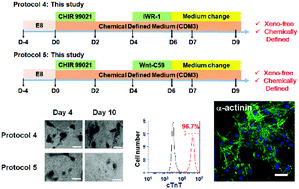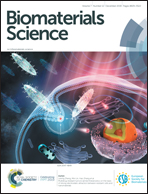Efficient differentiation of human ES and iPS cells into cardiomyocytes on biomaterials under xeno-free conditions†
Abstract
Current xeno-free and chemically defined methods for the differentiation of hPSCs (human pluripotent stem cells) into cardiomyocytes are not efficient and are sometimes not reproducible. Therefore, it is necessary to develop reliable and efficient methods for the differentiation of hPSCs into cardiomyocytes for future use in cardiovascular research related to drug discovery, cardiotoxicity screening, and disease modeling. We evaluated two representative differentiation methods that were reported previously, and we further developed original, more efficient methods for the differentiation of hPSCs into cardiomyocytes under xeno-free, chemically defined conditions. The developed protocol successively differentiated hPSCs into cardiomyocytes, approximately 90–97% of which expressed the cardiac marker cTnT, with beating speeds and sarcomere lengths that were similar to those of a healthy adult human heart. The optimal cell culture biomaterials for the cardiac differentiation of hPSCs were also evaluated using extracellular matrix-mimetic material-coated dishes. Synthemax II-coated and Laminin-521-coated dishes were found to be the most effective and efficient biomaterials for the cardiac differentiation of hPSCs according to the observation of hPSC-derived cardiomyocytes with high survival ratios, high beating colony numbers, a similar beating frequency to that of a healthy adult human heart, high purity levels (high cTnT expression) and longer sarcomere lengths similar to those of a healthy adult human heart.



 Please wait while we load your content...
Please wait while we load your content...